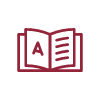How do I know I'm choosing books my professor would find appropriate?
What types of books should I use for my assignment?
You will find all types of books at the Library to support the research and student work that happens at Concordia. Not all of these books will be appropriate for all assignments. For example, we have many children’s books that are used by students and researchers in early education programs. However, if you are working on an assignment for a biology class, children’s books may not be appropriate sources.
Whether a book is appropriate for your research depends on your assignment and your topic. Take a look at your assignment. Does your professor give you guidelines as to the types of sources they want you to cite? Do they specify scholarly books? Do they ask for primary sources that can include books?
Below are some examples of different types of books you can find at the library. Refer to your assignment when deciding if the book type is appropriate. If you are ever in doubt, you can consult with a librarian.
 Primary sources
Primary sources
A primary source is "the first-hand evidence left behind by participants or observers at the time of an event."1 Books can be primary sources. For example, autobiographies, memoirs, poetry, novels, plays, letters, and diaries can all be considered primary sources.
Scholarly books are considered secondary sources as they will discuss, interpret, analyze or comment on primary sources.
For more information about finding and evaluating primary sources see the history guide.
1. California State University (Los Angeles) Library. (2017, July 21). What are Primary Sources. Retrieved from: https://libguides.csun.edu/history/primarysourcesTypes of books
Reference books are consulted for general information and facts. The information in them is typically arranged in a very specific way. For example, in dictionaries and encyclopedias, entries are presented alphabetically. Reference books are intended to be consulted, not read cover to cover.
One example of a type of reference book is the encyclopedia. Encyclopedias provide short overviews of specific topics within a certain area of study. Some encyclopedias, such as Encyclopedia Britannica, Oxford reference online premium, and Wikipedia, provide summaries on all areas of knowledge.
These are books that are written for a general, non-academic audience and are considered "popular". Academics may read and study these books, but they are written to entertain and inform readers of all levels and educational backgrounds. These books can be fiction or non-fiction.
Scholarly books focus on critical analysis or report on research. They are written by academics and researchers.
Criteria for evaluating academic or scholarly books
Author(s)
What are the author's credentials? Are they affiliated with a university or research institute? Is the book published by a scholarly press.
Language
Is the language specialized or technical? Does it assume a background in the subject area? Scholarly books will be written in academic language, assuming the reader understands the context and the subject area.
Structure
Scholarly books will have standard sections like a table of contents and frequently, an index. See the section "What are books and why use them?" to review the structure of a scholarly book.
References / Bibliography / Footnotes / Endnotes
Scholarly books will cite their sources and will present them in a Bibliography or Reference list either at the end of each chapter or at the end of the book. These citations will include all the information necessary to locate the sources.
 Scholarly Press
Scholarly Press
A publisher that publishes books for academic and research audiences. University presses are considered scholarly and usually easy to identify.




